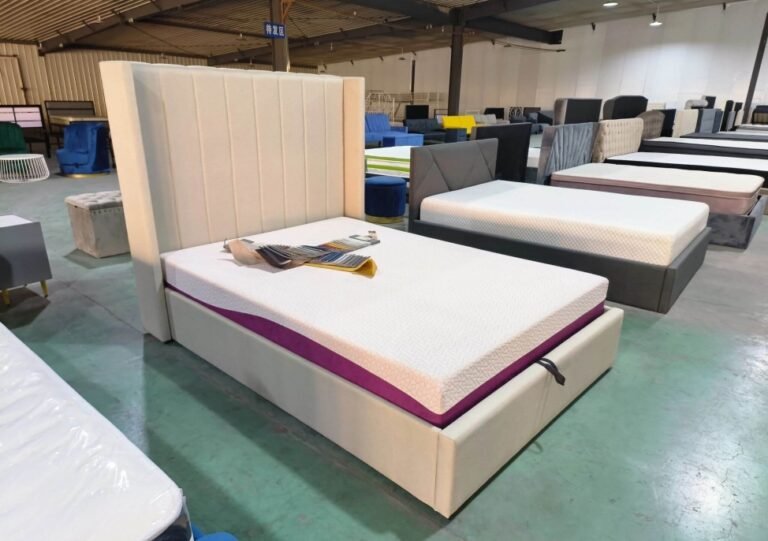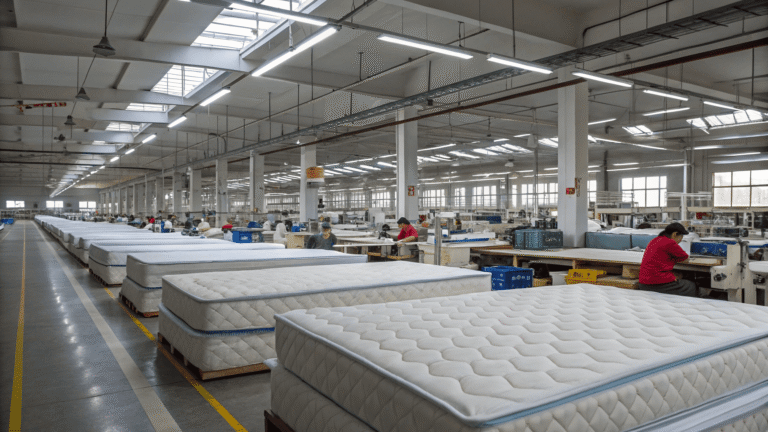Eco-friendly furniture is gaining traction, but bouclé beds pose a unique challenge. Retailers want soft, stylish pieces—but will they pass the “sustainability” test?
Yes, eco-friendly bouclé beds1 exist. They combine recycled or organic fabrics, low-VOC foam, FSC wood, and recyclable packaging for a cleaner supply chain.

More and more mid-range furniture retailers2 want to label their beds as “eco.” But before you dive in, you need to know which materials, certifications, and logistics work—or don’t. Let’s break it down step by step.
What makes a bouclé bed eco-friendly?
Eco-conscious buyers are no longer satisfied with surface-level greenwashing.
An eco-friendly bouclé bed typically features recycled or organic fabrics, certified wood frames, non-toxic foam, and recyclable or minimal packaging.

Not all “eco-friendly” claims are equal. As a furniture manufacturer, I get this question often: “Do I need to change everything or just the fabric?”
The real answer? It depends on the sustainability level you're aiming for. Here's how I usually break it down for clients:
| Component | Sustainable Option | Key Benefit |
|---|---|---|
| Fabric | Recycled polyester / Organic cotton | Lower carbon footprint |
| Filling | Low-VOC foam / Natural latex | Healthier indoor air |
| Frame | FSC-certified wood | Responsible forestry practices |
| Packaging | Recyclable or vacuum-pack friendly | Reduced waste and shipping costs |
You don’t need to tick every box. Many of my clients start with eco fabric + FSC frame, then upgrade foam later.
Are sustainable bouclé beds suitable for mid-range furniture retail?
You don’t want to offer beds that are either too niche or too expensive for your target customers.
Yes, eco bouclé beds can work for mid-range furniture retailers—if they balance sustainability with style, price, and shipping practicality.

When my Canadian clients ask, “Can I sell these beds in my store?” they really mean, “Will this move inventory without hurting margins?”
Here's what I tell them: the mid-range market doesn’t need perfection—it needs credibility, affordability, and good design. Most buyers won’t ask if your wood is FSC-certified, but if your tag says “eco-friendly,” they expect the product to look and feel premium.
Tips that work in this segment:
- Choose a recycled poly bouclé that looks just as good as new.
- Avoid overly minimal designs that feel “cold” to mid-range buyers.
- Stick to foams that recover well in vacuum packaging (no dented headboards).
- Focus your marketing on comfort + conscious living, not just sustainability.
What materials are used in green-certified bouclé beds3?
Not all “green” materials are created equal—and some sound good but perform poorly in reality.
Green-certified bouclé beds often use recycled polyester, GOTS-certified cotton, OEKO-TEX foam, and FSC wood frames.

Many of my customers confuse “natural” with “sustainable.” But natural wool, for example, isn’t always traceable or recyclable.
Here’s what I recommend based on real-world performance:
| Material | Certification | Pros | Cons |
|---|---|---|---|
| Recycled Polyester | GRS / OEKO-TEX | Looks like virgin fabric, vacuum-pack OK | May still shed microplastics |
| Organic Cotton Bouclé | GOTS | Breathable, low-toxin | Prone to wrinkling and discoloration |
| Low-VOC PU Foam | CertiPUR-US / OEKO-TEX | Holds shape, low off-gassing | Slightly higher cost |
| FSC Wood Frame | FSC | Trusted global standard | Limited availability in some regions |
You need to balance availability, cost, and look. For most eco designs, recycled poly bouclé wins for versatility and export handling.
Are there any certifications (e.g. FSC, GOTS) for eco bouclé beds?
Certifications do more than prove sustainability—they’re your retail insurance policy.
Yes, reputable eco-friendly bouclé beds often carry certifications like GOTS (textiles), FSC (wood), OEKO-TEX (fabric safety), and GRS (recycled content).

Certifications matter more in B2B than many suppliers realize. I’ve seen buyers walk away simply because a “recycled claim” couldn’t be backed by a label.
Here’s a cheat sheet I made for my sales team:
| Certification | What It Covers | Commonly Used On |
|---|---|---|
| FSC | Wood and plywood sourcing | Bed frames, slats, panels |
| GOTS | Organic textile processing | Bouclé cotton blends |
| OEKO-TEX | Harmful substances in fabric | Foam, fabric |
| GRS | Recycled content tracking | Recycled polyester bouclé |
Keep digital versions of these ready for your product pages. Buyers will ask—even if they don't say it up front.
Can bouclé beds be both eco-friendly and vacuum-packed for export?
Many sustainable materials look great—but don’t survive compression.
Yes, with the right structure, eco-friendly bouclé beds can be vacuum-packed for export without damage.

I’ve seen this issue ruin well-intended launches: a bed uses beautiful wool bouclé and soft organic padding...then arrives flattened beyond recognition.
The problem? Soft materials like cotton wadding or loose wool can't handle vacuum pressure. They shift, compress unevenly, and don’t bounce back.
The solution:
- Use recycled polyester bouclé for better tension and resilience.
- Choose HR (high-resilience) foam that rebounds well after compression.
- Design your bed head with dual-layer padding: firm inside, soft outside.
- Avoid feather or wool stuffing for compressed formats.
A structure like this keeps eco promises but still ships smart:
| Layer | Material |
|---|---|
| Outer Fabric | GRS-certified recycled poly |
| Outer Padding | Polyester fiberfill |
| Core Foam | CertiPUR-US HR foam |
| Frame | FSC-certified MDF/plywood |
This combo works especially well for clients exporting to Canada, Germany, and Northern Europe.
Is a bouclé bed a good idea?
The bouclé trend isn’t fading—it’s maturing. And that opens up new business opportunities.
Yes, bouclé beds are still a strong choice, especially when styled well and backed by sustainable features.

I’ve worked with clients who thought they were “late” to bouclé. But every year, we see new twists: curved shapes, deeper tones, modular functions.
If you can offer comfort + ethics, you’re not late—you’re upgraded.
Here’s what works now:
- Go beyond white. Think earthy tones (taupe, mushroom, olive).
- Combine bouclé with other materials—wood accents, linen trims.
- Push “sustainable softness” as a unique value. Eco meets cozy.
Bouclé isn’t going anywhere. The visual softness and texture help customers feel safe, grounded—and they associate that with quality.
Why is bouclé so popular?
You see it on couches, headboards, and even coffee table wraps. But why?
Bouclé fabric is popular because it looks soft, feels plush, hides wrinkles, and adds visual depth—especially in neutral tones.

In my experience, bouclé took off for three reasons:
- Emotional Comfort: Post-2020, customers craved warmth and softness. Bouclé offered that both physically and visually.
- Instagram Appeal: Its texture photographs well, especially in minimal homes.
- Versatile Look: It fits Scandinavian, Japandi, and Mid-century modern aesthetics—key styles for today’s consumers.
It also wears well. The looped yarn hides dirt and compression better than flat fabrics, which lowers return rates for retailers.
Eco-friendly bouclé combines trend appeal with market ethics. That’s a win-win if you’re offering it the right way.
Conclusion
Eco-friendly bouclé beds aren’t just a trend—they’re a profitable, shippable, and smart move for modern retailers who care about quality and branding.




